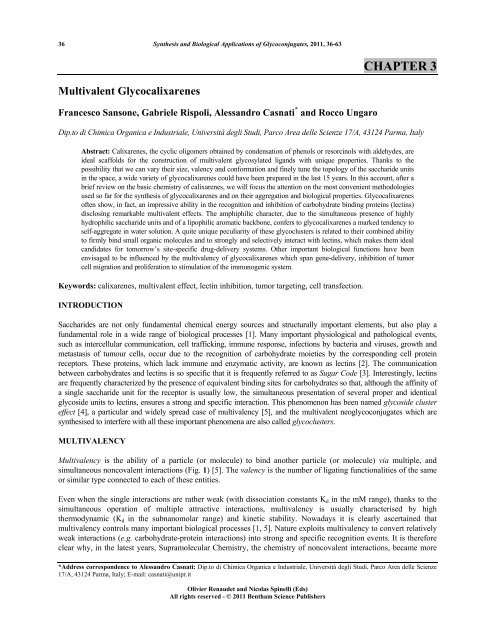chapter 2 - Bentham Science
chapter 2 - Bentham Science
chapter 2 - Bentham Science
You also want an ePaper? Increase the reach of your titles
YUMPU automatically turns print PDFs into web optimized ePapers that Google loves.
36 Synthesis and Biological Applications of Glycoconjugates, 2011, 36-63<br />
Multivalent Glycocalixarenes<br />
Francesco Sansone, Gabriele Rispoli, Alessandro Casnati * and Rocco Ungaro<br />
Olivier Renaudet and Nicolas Spinelli (Eds)<br />
All rights reserved - © 2011 <strong>Bentham</strong> <strong>Science</strong> Publishers<br />
CHAPTER 3<br />
Dip.to di Chimica Organica e Industriale, Università degli Studi, Parco Area delle Scienze 17/A, 43124 Parma, Italy<br />
Abstract: Calixarenes, the cyclic oligomers obtained by condensation of phenols or resorcinols with aldehydes, are<br />
ideal scaffolds for the construction of multivalent glycosylated ligands with unique properties. Thanks to the<br />
possibility that we can vary their size, valency and conformation and finely tune the topology of the saccharide units<br />
in the space, a wide variety of glycocalixarenes could have been prepared in the last 15 years. In this account, after a<br />
brief review on the basic chemistry of calixarenes, we will focus the attention on the most convenient methodologies<br />
used so far for the synthesis of glycocalixarenes and on their aggregation and biological properties. Glycocalixarenes<br />
often show, in fact, an impressive ability in the recognition and inhibition of carbohydrate binding proteins (lectins)<br />
disclosing remarkable multivalent effects. The amphiphilic character, due to the simultaneous presence of highly<br />
hydrophilic saccharide units and of a lipophilic aromatic backbone, confers to glycocalixarenes a marked tendency to<br />
self-aggregate in water solution. A quite unique peculiarity of these glycoclusters is related to their combined ability<br />
to firmly bind small organic molecules and to strongly and selectively interact with lectins, which makes them ideal<br />
candidates for tomorrow’s site-specific drug-delivery systems. Other important biological functions have been<br />
envisaged to be influenced by the multivalency of glycocalixarenes which span gene-delivery, inhibition of tumor<br />
cell migration and proliferation to stimulation of the immunogenic system.<br />
Keywords: calixarenes, multivalent effect, lectin inhibition, tumor targeting, cell transfection.<br />
INTRODUCTION<br />
Saccharides are not only fundamental chemical energy sources and structurally important elements, but also play a<br />
fundamental role in a wide range of biological processes [1]. Many important physiological and pathological events,<br />
such as intercellular communication, cell trafficking, immune response, infections by bacteria and viruses, growth and<br />
metastasis of tumour cells, occur due to the recognition of carbohydrate moieties by the corresponding cell protein<br />
receptors. These proteins, which lack immune and enzymatic activity, are known as lectins [2]. The communication<br />
between carbohydrates and lectins is so specific that it is frequently referred to as Sugar Code [3]. Interestingly, lectins<br />
are frequently characterized by the presence of equivalent binding sites for carbohydrates so that, although the affinity of<br />
a single saccharide unit for the receptor is usually low, the simultaneous presentation of several proper and identical<br />
glycoside units to lectins, ensures a strong and specific interaction. This phenomenon has been named glycoside cluster<br />
effect [4], a particular and widely spread case of multivalency [5], and the multivalent neoglycoconjugates which are<br />
synthesised to interfere with all these important phenomena are also called glycoclusters.<br />
MULTIVALENCY<br />
Multivalency is the ability of a particle (or molecule) to bind another particle (or molecule) via multiple, and<br />
simultaneous noncovalent interactions (Fig. 1) [5]. The valency is the number of ligating functionalities of the same<br />
or similar type connected to each of these entities.<br />
Even when the single interactions are rather weak (with dissociation constants Kd in the mM range), thanks to the<br />
simultaneous operation of multiple attractive interactions, multivalency is usually characterised by high<br />
thermodynamic (Kd in the subnanomolar range) and kinetic stability. Nowadays it is clearly ascertained that<br />
multivalency controls many important biological processes [1, 5]. Nature exploits multivalency to convert relatively<br />
weak interactions (e.g. carbohydrate-protein interactions) into strong and specific recognition events. It is therefore<br />
clear why, in the latest years, Supramolecular Chemistry, the chemistry of noncovalent interactions, became more<br />
*Address correspondence to Alessandro Casnati: Dip.to di Chimica Organica e Industriale, Università degli Studi, Parco Area delle Scienze<br />
17/A, 43124 Parma, Italy; E-mail: casnati@unipr.it

















